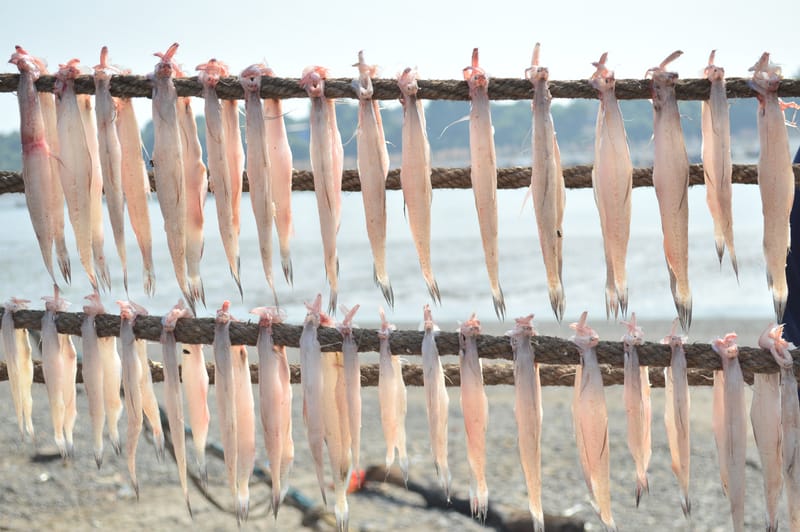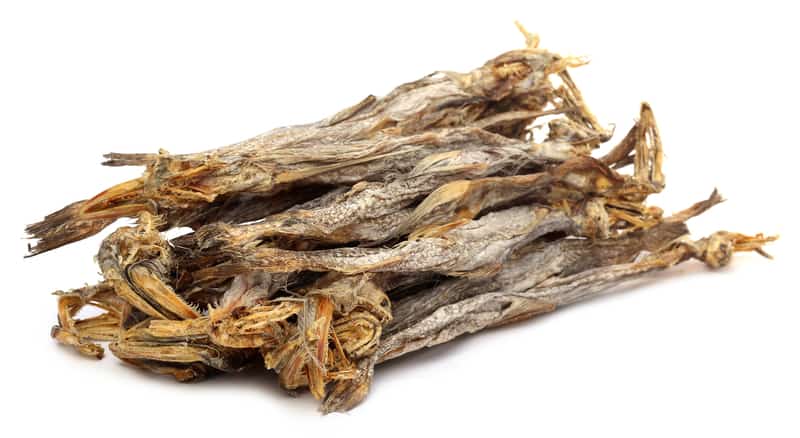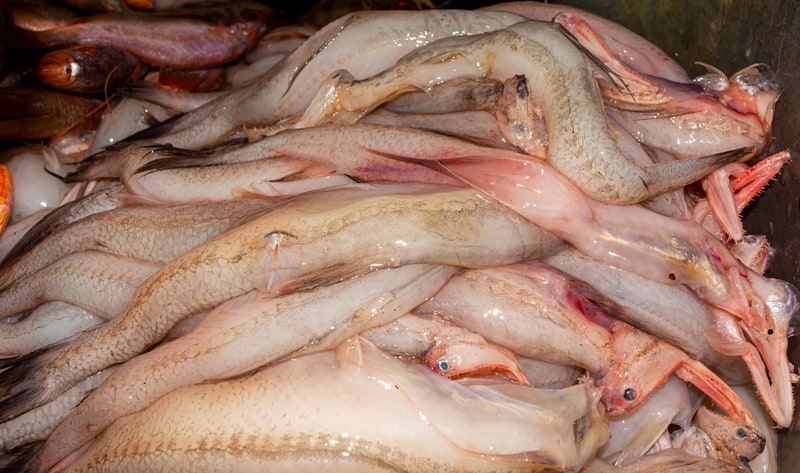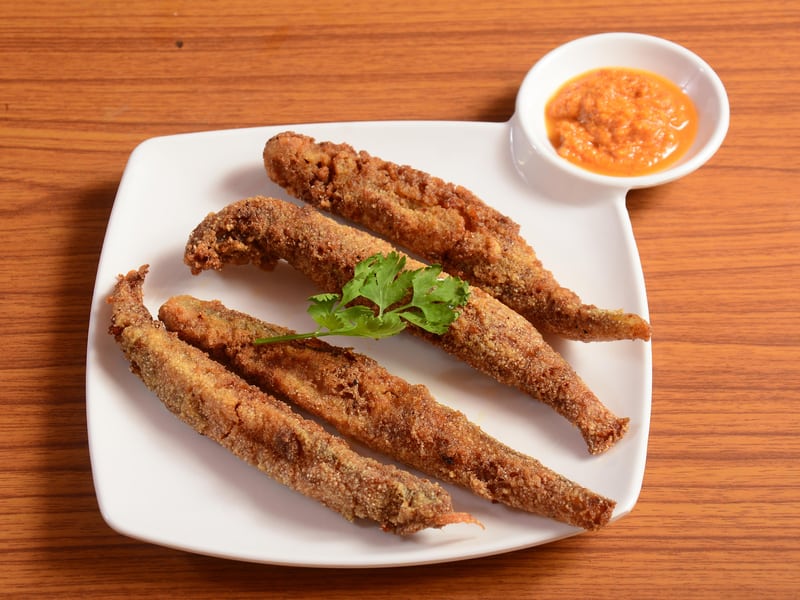
Bombay duck is not a bird but a fish known locally as one of Mumbai’s most popular dishes. Other names for Bombay Duck include “bumalo,” “bummalo,” and “bombil.”.
Bombay duck can be prepared in many ways. The fish is usually cleaned, deboned, and sun-dried before it is cooked. The traditional method of drying fish involves placing it on bamboo poles buried in sand and securing it with broad horizontal ropes. Many food vendors display this type of drying technology.
History of Bombay Duck
While the name suggests it should be a type of bird, the Bombay Duck is a type of fish. The fish’s scientific name is Harpadon nehereus, but its common names include bamaloh, bumla, and Bombil in Indian dialects.
It is a staple diet for the underprivileged along the coastal seas of Southeast Asia and Western India. In British-Indian cuisine, it was referred to as Bombay Duck when it was preserved in salt.
The most famous feature of Bombay Duck is its unbelievably strong stench, which escapes even the tightest of containers and has little to do with duck. The smelly crumbly dried fish was so beloved by returning Britons that it was imported into England more than 13 tons per year until 1997.

A prohibition on Indian fish not being canned or frozen in facilities that were “authorized” was enacted by the European Commission of the European Union in 1997.
Why is it famous in Mumbai?
Mumbai waters are the only place you’ll ever find Bombil, which is not exactly a duck but a highly fatty fish. According to legend, this is the case. As he built a bridge to Lanka, it is said that Lord Rama asked for the help of every sea creature.
Bombil was the only one who didn’t heed the summons. Angry, Rama hurled it into the ocean off the coast of Mumbai. This also explains the softness of its bones.
Why is it Bombay duck?
This is the subject of fascinating stories. According to legend, this fish was named because of the British postal trains that transported it. Bombay Dak, or Bombay mail, was so coined for these carts. You may have misheard it as ‘bombil,’ which is Marathi for ‘Bombay’ (a type of fish).
What does Bombay duck taste like?
What’s so appealing about Bombay Duck? Why? It has a peculiar flavor inexplicably reminiscent of the sea in every swallow. Dried Bombay Duck is an excellent alternative for those not keen on seafood. It has a salty, fishy flavor and a crumbly, brittle texture. Dried Bombay Duck has a salty, cheesy aftertaste that lingers in your mouth long after you’ve finished a piece.
Fresh Bombay duck is cooking in most of the homes in Mumbai. It’s either fried by dipping it in Rawa or bread crumbs or prepared with shallow gravy.
Where can I get Bombay duck?
Fresh Bombay Duck may be purchased from Licious between April and September. They hygienically clean, prepare and pack the delicate parts of the fish, and it is ready to go into your cooking pot immediately! Depending on your requirements, they can provide the entire, cleaned Bombay Duck in various sizes.
This fish is readily available in any local market around Mumbai and almost annually. It is very economical compared to other fish. Hence it is released by most Mumbaikars.
How is Bombay Duck different from other fish?
It is a marine fish that may be found in the waters off the coast of Maharashtra in the Lakshadweep Sea. Despite its unappetizing appearance, this fatty fish’s strong perfume has earned it a reputation as one of Mumbai’s best-known delicacies!
This fish is also known as a bombil, bummalo, and boomla. It’s common to see orderly rows of these fish hanging on racks, drying in the sun, on Mumbai’s various beaches.

How it is prepared – Fried, Dried, Gravy
Various preparations for this fish are popular, including baking, frying, or incorporating it into a flavorful curry.
It is a favorite dish of Parsis, who cover the fresh Bombay Duck with Rawa (semolina) and deep-fry it till it’s golden brown on the surface but juicy and soft inside. This tiny fish is prone to breaking apart.
The famed Malwani restaurants in Mumbai have experimented with the Bombay duck to produce gastronomic experiences that are out of this world.
They make the fish even crisper by draining the water from it, resulting in a product that crumbles in your mouth like wafers when you bite into it.
It’s nirvana on a plate as part of a seafood thali with sol kadi, cawal, rassa, and chapatis. It can also be used in various cuisines, such as a dry bombil chilly fry or consumed as a chutney or pickle.
How much does Bombay Duck cost?
Raw Bombay Duck cleaned and sorted will cost around Rs. 300 per kg if purchased online. However, the same 1 Kg. from the local fish market can cost as low as Rs. 100 and even cheaper from the Malad or Bhau ka Dhaka wholesale fish market.
Best Restaurant in Mumbai to eat Bombay Duck
The greatest place in Mumbai to have Bombay Duck is Gomantak Restaurant in Dadar West.

What is the recipe for curry?
Cooking instructions and ingredients for the Bombay Duck Curry Recipe. 4 medium-sized portions of Bombay duck (Bombil) after being cleaned and sliced into 3-inch pieces and scraped half a cup of coconut. Twelve cups of finely chopped fresh coriander, if necessary. Green chiles have been smashed into two pieces. A tamarind ball the size of a lemon. 2 tbsp. Dried red chili flakes. 12 teaspoons of turmeric powder.
Here’s a simple recipe for Bombay Duck Curry
Ingredients:
- 6-8 Bombay Ducks (also known as Bombil or Bummalo)
- 2 onions, finely chopped
- 2 tomatoes, pureed
- 2 teaspoons ginger-garlic paste
- 1 teaspoon turmeric powder
- 1 teaspoon red chili powder
- 1 teaspoon cumin powder
- 1 teaspoon coriander powder
- 1/2 teaspoon garam masala
- 1/2 teaspoon mustard seeds
- 1/2 teaspoon fenugreek seeds
- 4-5 curry leaves
- 2 tablespoons vegetable oil
- Salt to taste
- Fresh coriander leaves for garnishing
Instructions:
- Clean the Bombay Ducks thoroughly, removing their heads and internal organs. Wash them under running water and pat them dry with a kitchen towel. Cut them into medium-sized pieces.
- Heat oil in a large pan or kadhai over medium heat. Add mustard seeds and fenugreek seeds. Allow them to crackle for a few seconds.
- Add chopped onions and curry leaves to the pan. Sauté until the onions turn golden brown.
- Add ginger-garlic paste and cook for a minute until the raw smell disappears.
- Reduce the heat to low and add turmeric powder, red chili powder, cumin powder, and coriander powder. Mix well and cook the spices for a minute.
- Add tomato puree to the pan and cook until the oil separates from the masala.
- Add the Bombay Duck pieces to the pan and gently coat them with the masala. Be careful not to break the delicate fish pieces.
- Season with salt and cover the pan. Cook for about 10-15 minutes on low heat, allowing the fish to absorb the masala flavors. Stir occasionally to prevent sticking.
- Sprinkle garam masala over the curry and give it a gentle stir. Cook for an additional 2-3 minutes.
- Turn off the heat and garnish with fresh coriander leaves.
- Serve hot with steamed rice or roti.
Enjoy your delicious Bombay Duck Curry!
Leave a Reply